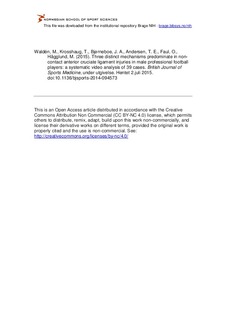Three distinct mechanisms predominate in non-contact anterior cruciate ligament injuries in male professional football players: a systematic video analysis of 39 cases
Waldén, Markus; Krosshaug, Tron; Bjørneboe, John; Andersen, Thor Einar; Faul, Oliver; Hägglund, Martin
Journal article, Peer reviewed
Permanent lenke
http://hdl.handle.net/11250/295121Utgivelsesdato
2015-04-23Metadata
Vis full innførselSamlinger
- Artikler / Articles [2119]
Originalversjon
British Journal of Sports Medicine. 2015, under utgivelse. doi:10.1136/bjsports-2014-094573Sammendrag
Background: Current knowledge on anterior cruciate ligament (ACL) injury mechanisms in male football players is limited.
Aim: To describe ACL injury mechanisms in male professional football players using systematic video analysis.
Methods: We assessed videos from 39 complete ACL tears recorded via prospective professional football injury surveillance between 2001 and 2011. Five analysts independently reviewed all videos to estimate the time of initial foot contact with the ground and the time of ACL tear. We then analysed all videos according to a structured format describing the injury circumstances and lower limb joint biomechanics.
Results: Twenty-five injuries were non-contact, eight indirect contact and six direct contact injuries. We identified three main categories of non-contact and indirect contact injury situations: (1) pressing (n=11), (2) re-gaining balance after kicking (n=5) and (3) landing after heading (n=5). The fourth main injury situation was direct contact with the injured leg or knee (n=6). Knee valgus was frequently seen in the main categories of non-contact and indirect contact playing situations (n=11), but a dynamic valgus collapse was infrequent (n=3). This was in contrast to the tackling-induced direct contact situations where a knee valgus collapse occurred in all cases (n=3).
Conclusions: Eighty-five per cent of the ACL injuries in male professional football players resulted from non-contact or indirect contact mechanisms. The most common playing situation leading to injury was pressing followed by kicking and heading. Knee valgus was frequently seen regardless of the playing situation, but a dynamic valgus collapse was rare.
Beskrivelse
This is an Open Access article distributed in accordance with the Creative Commons Attribution Non Commercial (CC BY-NC 4.0) license, which permits others to distribute, remix, adapt, build upon this work non-commercially, and license their derivative works on different terms, provided the original work is properly cited and the use is non-commercial. See: http://creativecommons.org/licenses/by-nc/4.0/
